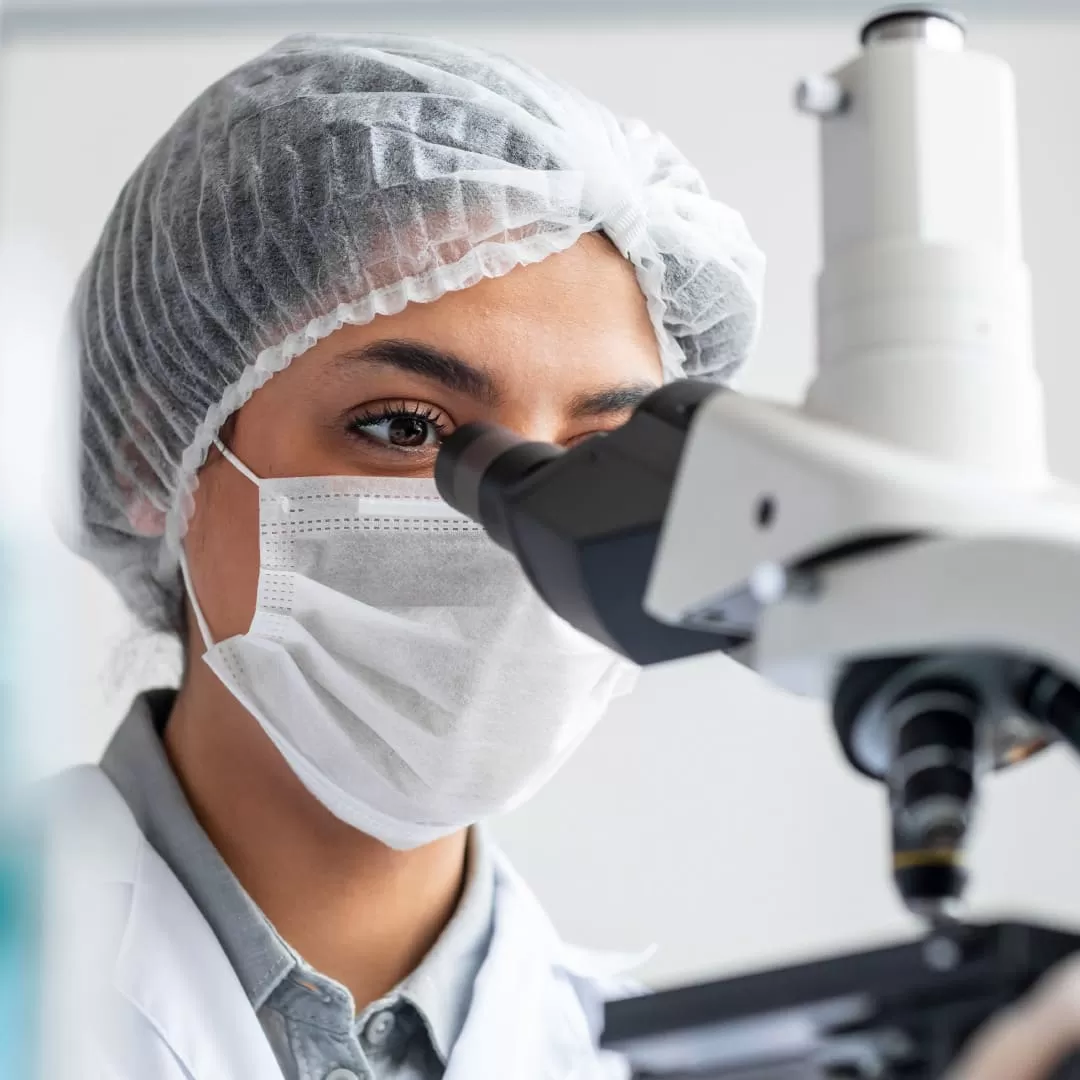In Vitro Fertilisation treatment requires the fertility specialist to remove eggs from the ovary and fertilise them with the partner’s sperm in the laboratory. The eggs and sperm unite to form embryos (fertilised eggs), which are then transferred into the uterus.

IVF treatment is beneficial for people with:
Blocked Fallopian tubes
Unexplained infertility where routine tests do not indicate any abnormality in the couple
Poor ovarian reserve
Moderate/severe Endometriosis
Male factor - severe abnormalities in the sperm parameters such as very low sperm count/motility
Advanced female age
Process of IVF treatment

Step 1
Ovarian Stimulation
In a normal menstrual cycle, only one follicle – a sac that contains an egg, usually reaches maturity.
Read More
However, in an IVF cycle, we aim to stimulate the growth of several follicles so that many eggs are available for fertilisation. It increases the chance of success, and we use the most secure and commonly used injections to develop a good number of follicles in the ovary. The stimulation injections are given for 10 to 14 days, starting from the first or second day of periods until the follicles reach 18 mm or more. Some injections are given subcutaneously, which means it is injected under the skin and other injections into the muscle. The most common side effects noted are a slight inflammation at the injection site, transient fever, and joint pains.

Step 2
Monitoring Egg Growth with Ultrasound
While taking stimulation injections, growth and number of follicles in the ovaries is monitored with the help of ultrasounds. On an average, we carry out three to four ultrasounds.
Read More
On average, three to four scans are carried out while taking the stimulation injections to monitor follicle growth in the ovaries. The egg collection procedure can be planned when at least three follicles reach 18mm in size. Monitoring the follicle growth is very important to adjust the dose of medication and identify ovaries’ excessive stimulation, which may result in potentially serious side effects known as ovarian hyperstimulation syndrome (OHSS). Hormonal assays in the blood might be performed if there is evidence of excessive response to guide management.

Step 3
Ovulation Trigger
HCG is administered once the follicles reach the desired size, which is necessary for the final maturation of the egg.
Read More
HCG is given once the follicles reach the desired size, which is necessary for the final maturation of the egg. This injection is given late in the evening, two days before the day of egg retrieval. It triggers the final maturation of the egg, and the next step, i.e. oocyte retrieval, is then scheduled at 36 hours after administration of HCG.

Step 4
Egg Collection Procedure
The collected eggs are stored in a special incubator in the laboratory.
Read More
The incubator mirrors the human body environment in terms of temperature and pH. Most women find the process of egg collection uncomfortable rather than painful. There may be mild cramps or slight bleeding from the vagina, which usually subsides in a few hours. Oral antibiotics are given as prophylaxis against infection. You are allowed to go home 2-3 hours after the procedure.

Step 5
Sperm Preparation
On the day of egg collection, the husband needs to produce a semen sample by masturbation in a clean wide-mouthed container supplied by the lab.
Read More
A fresh sample of semen is ideal, but if the husband cannot be present at the scheduled time, a semen sample can be collected and frozen in advance. If the husband has difficulty producing the sample, please inform us in advance so that we can freeze a few samples before starting the IVF cycle. This process is called backup sperm freezing. The semen sample is processed to obtain a clean, concentrated, highly motile sperm used to inseminate the eggs. It is necessary to add a relatively small but decent number of sperm to inseminate the eggs.

Step 6
Fertilisation
A measured volume of the prepared sperm suspension is added to the dish containing the eggs three to six hours after egg collection.
Read More
A measured volume of the prepared sperm suspension is added to the dish containing the eggs 3-6 hours after egg collection. The following day the dish is checked for fertilised eggs. They are then placed in fresh dishes of culture medium and replaced in the incubator. ICSI (IntraCytoplasmic Sperm Injection) is a procedure where a single selected sperm is injected into the egg’s cytoplasm to fertilise the egg. It is recommended for male subfertility and in a few other indications, such as unexplained subfertility.

Step 7
Embryo Transfer (ET), Implantation and Outcome
Embryo transfer is carried out on any day between the 2nd day and 5th day after oocyte retrieval. ET is a simple procedure done under aseptic conditions. No sedation is required.
Read More
- The embryos are gently placed in the uterine cavity through a fine cannula introduced directly into the uterus via the vagina and cervix.
- Progesterone in the form of vaginal gel is given to support conception. Typically two to three embryos are placed in the uterine cavity. You do not need complete bed rest for two weeks and carry on with your routine activities and regular diet. You are advised not to have sexual intercourse during this period.
- Once the embryos are transferred, they should follow the natural implantation event. The embryo hatches out of its shell covering (zona pellucida) and implants into the endometrium by burrowing into it. It then continues to develop to the fetus. Once implanted, the embryo starts producing the hormone hCG revealed in a pregnancy test.
- The presence of the hCG hormone confirms pregnancy. A blood test indicating Beta hCG levels confirms pregnancy on the 12th day after embryo transfer. If Beta hCG is positive, we advise you to follow up after two weeks for an ultrasound. However, if it is lower than the ideal value, we repeat Beta hCG values to monitor the pregnancy.
In cases of a failed outcome, regular menses will usually resume within a day or two after the negative result.
With one cycle of IVF, the pregnancy live birth rate is around 50%. However, the cumulative pregnancy rate after three cycles of IVF is very good.
Factors that Influence IVF Success Rates
IVF is a multi-step process, and couples about to undergo IVF are concerned about their individual chances of success. Here are some factors that influence the success rates!

Ovarian Reserve
Women with a good number of eggs indicating good ovarian reserve have a better chance of pregnancy compared to others.

Previous Pregnancies
Women with a history of previous pregnancies, miscarriage, ectopic, or live birth seem to have better chances than others, indicating successful implantation.

Age
Female age is the most crucial factor which influences the success rates of IVF. Female age is an essential factor in influencing the chances of natural conception or following any fertility treatment, be it IUI or IVF. Though IVF success rates are high in women under 35 years, even as women age, the maximum chance of conception is with IVF as compared to any other treatments.

Choice of IVF Clinic
One of the most critical factors determining the success rate of IVF is the choice of the IVF Centre. Proper research regarding the doctor’s expertise performing IVF, their credentials and training matter most. In addition lab with state-of-the-art facilities, and the expertise of the scientists who perform the procedure is also equally important. Evidence-based treatments, quality control, and witnessing procedures go a long way in making the difference in pregnancy rates between an average IVF clinic and the best one.
Book an Appointment
Patients who book an appointment for Thursdays get to consult our Expert Doctor for free. This offer is valid for a limited time and only applicable for patients with a prior valid appointment. Timings: Thursdays – 10 AM to 4 PM
Book your appointment on a Thursday to get a free consultation and take your first step towards Parenthood…

